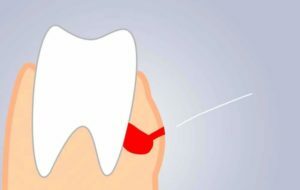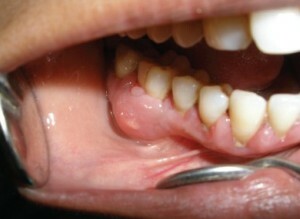 Flux is a fairly common disease that, if left untreated, can cause serious consequences.
Flux is a fairly common disease that, if left untreated, can cause serious consequences.
If symptoms appear, you can take medication or folk remedies, but you will not be able to avoid visiting the dentist.
Contents of
- What is flux on the gum?
- Rinse aid
- Homemade rinse aid
- What can not be done in any case
What is flux on the gum?
 Flux is otherwise called odontogenic periostitis. It is often caused by tooth decay, but it is also provoked by trauma, inflammation of the gingival canals, and improper hygiene of the oral cavity.
Flux is otherwise called odontogenic periostitis. It is often caused by tooth decay, but it is also provoked by trauma, inflammation of the gingival canals, and improper hygiene of the oral cavity.
The disease is caused by the activity of infectious cells that fall into the spaces between the teeth and the gingival tissues.
As a result, the formation of pus begins, which affects the periodontium, destroys the bone tissue of the tooth. If you do not provide timely assistance, pus can spread to the jawbone, get into internal organs or the brain as a result of penetration into the blood.
Drug remedies for rinsing
To relieve pain with a flux on the gum and to reduce puffiness, you can use medication. These include:
- Chlorhexidine;
- Furacilin;
- Betadine;
- Malawi;
- Rotokan.
Features of use of each medicine:
- Chlorhexidine is considered a universal remedy for the control of pathogenic microflora. When rinsing, it removes inflammation and promotes wound healing. With flux, it is recommended to use a 0.5% aqueous solution of the drug four times a day until symptoms disappear.
- Furacilin is a potent antibacterial drug. To prepare the solution, you need to dilute 2 tablets in a glass with boiling water. The cavity of the mouth rinses every two to three hours before the edema is removed and the pain stops.
- Betadine acts on the lesion focus and is a strong anti-inflammatory, antimicrobial, regenerative agent due to active iodine in its composition. To relieve the symptoms of the flux, it is necessary to prepare a solution of 1%
 preparation diluted in a quarter cup of warm water. The procedure should be performed four times a day at the same intervals until the symptoms are completely eliminated.
preparation diluted in a quarter cup of warm water. The procedure should be performed four times a day at the same intervals until the symptoms are completely eliminated. - Malavit contains natural squeezed out of medicinal plants, copper and silver ions. Incoming components help fight bacteria, block the spread of pathogenic cells, relieve swelling of tissues and pain syndrome. To prepare the solution, use a glass of warm unboiled water, 10 drops of the agent are added to it. Rinses are recommended to be carried out until symptoms are eliminated 7 times during the day. Once the symptoms disappear, it is recommended to continue the rinsing of the flux until complete recovery, but reduce the number of doses per day to three.
- Rotokan is an alcoholic tincture from herbs: yarrow, camomile, calendula. The drug has anti-inflammatory, antiseptic, anesthetic properties. Every 2-3 hours, rinse the mouth with a solution of a glass of warm water and a teaspoon of rotochak. As soon as the symptoms cease to be pronounced, you can go into a gentle regimen and rinse in the area of the aching tooth 3-4 times a day.
Homemade rinse aid
How can I rinse the flux on the gums at home?
 The most effective home remedy for flux treatment on the gums is soda-salt solution. It has anti-inflammatory, antibacterial, anesthetic effect. To make it, you need a teaspoon of salt and soda for a glass of warm water.
The most effective home remedy for flux treatment on the gums is soda-salt solution. It has anti-inflammatory, antibacterial, anesthetic effect. To make it, you need a teaspoon of salt and soda for a glass of warm water.
Rinsing is carried out at regular intervals 6-7 times during for the complete disappearance of the symptoms of the flux. To add wound healing properties and strengthening the existing ones, two drops of iodine can be added to the solution.

Scintillator
The use of herbs is very popular.
To normalize healthy microflora in the oral cavity, destroy pathogenic bacteria and remove pain syndrome, sage, mustard plaster, and bluehead will do.
Six tablespoons of dry herbal collection pour 300 ml of vodka or boiled water. Insist herbs under the closed lid for at least two hours, after which the solution is filtered and rinsed in the area of the aching tooth every two hours.
 For any problems with the oral cavity, tincture on the oak bark can be used. For 2.5 cups of boiling water, add two tablespoons of dry crushed bark, leave the tincture for 30 minutes, then rinse the mouth as often as possible during the day.
For any problems with the oral cavity, tincture on the oak bark can be used. For 2.5 cups of boiling water, add two tablespoons of dry crushed bark, leave the tincture for 30 minutes, then rinse the mouth as often as possible during the day.
The amount of rinses can go up to 8-10 times. The drug will relieve pain, moderate puffiness, help normalize a healthy microflora.

Acacia yellow
Pharmacy yellow acacia is often used to make tinctures to combat flux. A quarter of a glass of flowers should be insisted in a glass of boiling water for 20 minutes.
After complete cooling of the solution, it is possible to start treatment of the affected area. Inflammation will noticeably subside during the day, the pain will subside.
To remove pain and fight infection, you can use mint, birch buds, periwinkle, forest angelica. These ingredients are poured in equal proportions with boiling water or vodka and insist for half an hour. Rinsing with strained infusion is carried out every two hours.
What can not be done in any case
 The described methods can reduce pain and reduce edema, but in no case can warm the affected area or do warming lotions and compresses .They are capable of provoking the growth of purulent cells, resulting in the spread of infection and infection of other organs.
The described methods can reduce pain and reduce edema, but in no case can warm the affected area or do warming lotions and compresses .They are capable of provoking the growth of purulent cells, resulting in the spread of infection and infection of other organs.
You can not let the disease into its own right, limiting itself to rinsing at home. A visit to the dentist must be mandatory, as only he can eliminate the source of infection and reduce the risk of its secondary manifestation.
Before taking a doctor, you should not take painkillers for three hours. Antiseptics can make diagnosis and treatment more difficult.
If, 12 hours after the procedure, the soreness does not pass, it is important to visit the dentist again.
A full treatment of the flux is discussed in this video:
After the treatment, the edema may persist for another three days, sometimes it even increases slightly. Do not be afraid of this. Also, do not touch the drain. He must remain in the same place until the next visit to the dentist.
If the symptoms are removed in a timely manner and the dentist is consulted, you can effectively help the sick tooth and not only get rid of the flux, but also keep the tooth without serious effects on it.
